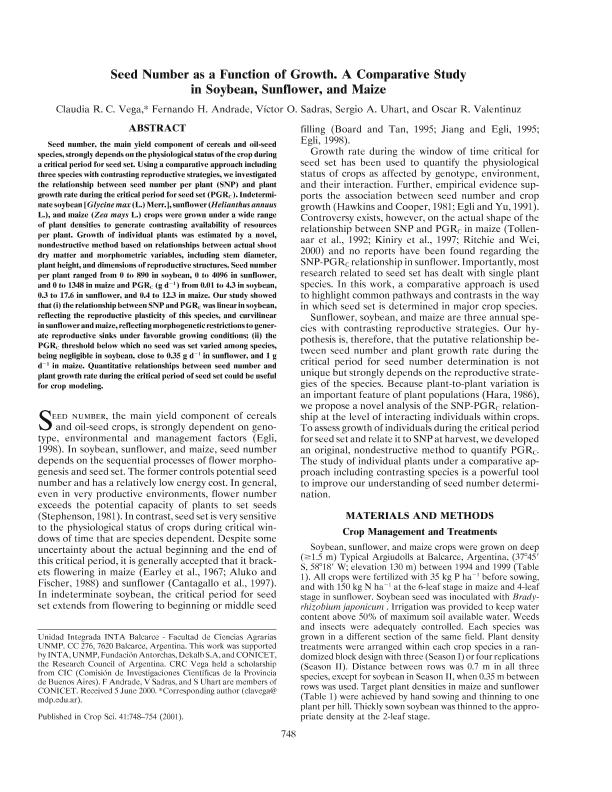Artículo
Seed number as a function of growth: A comparative study in soybean, sunflower, and maize
Vega, Claudia Rosa Cecilia ; Andrade, Fernando Héctor
; Andrade, Fernando Héctor ; Sadras, Victor Oscar
; Sadras, Victor Oscar ; Uhart, Sergio Adolfo
; Uhart, Sergio Adolfo ; Valentinuz, Oscar Rodolfo
; Valentinuz, Oscar Rodolfo
 ; Andrade, Fernando Héctor
; Andrade, Fernando Héctor ; Sadras, Victor Oscar
; Sadras, Victor Oscar ; Uhart, Sergio Adolfo
; Uhart, Sergio Adolfo ; Valentinuz, Oscar Rodolfo
; Valentinuz, Oscar Rodolfo
Fecha de publicación:
06/2001
Editorial:
Crop Science Society of America
Revista:
Crop Science
ISSN:
0011-183X
e-ISSN:
1435-0653
Idioma:
Inglés
Tipo de recurso:
Artículo publicado
Clasificación temática:
Resumen
Seed number, the main yield component of cereals and oil-seed Growth rate during the window of time critical for species, strongly depends on the physiological status of the crop during a critical period for seed set. Using a comparative approach including seed set has been used to quantify the physiological three species with contrasting reproductive strategies, we investigated status of crops as affected by genotype, environment, the relationship between seed number per plant (SNP) and plant and their interaction. Further, empirical evidence supgrowth rate during the critical period for seed set (PGRC ). Indetermi- ports the association between seed number and crop nate soybean [Glycine max (L.) Merr.], sunflower (Helianthus annuus growth (Hawkins and Cooper, 1981; Egli and Yu, 1991). L.), and maize (Zea mays L.) crops were grown under a wide range Controversy exists, however, on the actual shape of the of plant densities to generate contrasting availability of resources relationship between SNP and PGRC in maize (Tollen- per plant. Growth of individual plants was estimated by a novel, aar et al., 1992; Kiniry et al., 1997; Ritchie and Wei, nondestructive method based on relationships between actual shoot 2000) and no reports have been found regarding the dry matter and morphometric variables, including stem diameter, SNP-PGRC relationship in sunflower. Importantly, most plant height, and dimensions of reproductive structures. Seed number per plant ranged from 0 to 890 in soybean, 0 to 4096 in sunflower, research related to seed set has dealt with single plant and 0 to 1348 in maize and PGRC (g d21 ) from 0.01 to 4.3 in soybean, species. In this work, a comparative approach is used 0.3 to 17.6 in sunflower, and 0.4 to 12.3 in maize. Our study showed to highlight common pathways and contrasts in the way that (i) the relationship between SNP and PGRC was linear in soybean, in which seed set is determined in major crop species. reflecting the reproductive plasticity of this species, and curvilinear Sunflower, soybean, and maize are three annual spe- in sunflower and maize, reflecting morphogenetic restrictions to gener- cies with contrasting reproductive strategies. Our hy- ate reproductive sinks under favorable growing conditions; (ii) the pothesis is, therefore, that the putative relationship be- PGRC threshold below which no seed was set varied among species, tween seed number and plant growth rate during the being negligible in soybean, close to 0.35 g d21 in sunflower, and 1 g critical period for seed number determination is not d21 in maize. Quantitative relationships between seed number and unique but strongly depends on the reproductive strate- plant growth rate during the critical period of seed set could be useful for crop modeling.
Palabras clave:
SEED NUMBER
,
HELIANTHUS ANNUUS
,
GLYCINE MAX
,
ZEA MAYS
Archivos asociados
Licencia
Identificadores
Colecciones
Articulos(OCA PQUE. CENTENARIO)
Articulos de OFICINA DE COORDINACION ADMINISTRATIVA PQUE. CENTENARIO
Articulos de OFICINA DE COORDINACION ADMINISTRATIVA PQUE. CENTENARIO
Citación
Vega, Claudia Rosa Cecilia; Andrade, Fernando Héctor; Sadras, Victor Oscar; Uhart, Sergio Adolfo; Valentinuz, Oscar Rodolfo; Seed number as a function of growth: A comparative study in soybean, sunflower, and maize; Crop Science Society of America; Crop Science; 41; 3; 6-2001; 748-754
Compartir
Altmétricas



